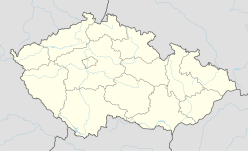Bohemian crater
| Impact crater/structure | |
|---|---|
| Confidence | Potential[1] |
| Diameter | ~260 km (160 mi) |
| Age | 2 Ga Paleoproterozoic |
| Exposed | Yes |
| Drilled | No |
| Location | |
| Location | Bohemian Massif |
| Coordinates | 50°36′N 14°24′E / 50.6°N 14.4°ECoordinates: 50°36′N 14°24′E / 50.6°N 14.4°E ⧼validator-fatal-error⧽ [1] |
| Country | Czech Republic |
| State | Bohemia |
The Bohemian crater, also called Czech crater, is a working hypothesis that considers the Bohemian Massif as an approximately two billion year old potential impact crater of 260 kilometres (160 mi) diameter.[1] This is contrary to the mainstream geological theory of plate tectonics, which explains the Bohemian Massif as the result of collision of independent continental units, occurring more than 300 million years ago.
Evolution of the hypothesis[edit]
A first comparison of the craters on the Moon and the Czech circular structure was made by Galileo Galilei in 1610.[2] Boston University astronomers Farouk El-Baz and Michael D. Papagiannis informed about the structure in 1980's as well.[3] So did also Petr Rajlich in 1992.[4] He informed about the discovery of an impact breccia. Rajlich, Benes and Cobbold also proposed a tectonic experiment related to the hypothesis in 1996.[5] They demonstrated the origin of roughly circular ridges around the Bohemian Massif as a result of simple lithospheric wrenching.
There exist many results of radiometric dating from the Bohemian Massif like zircon, muscovite or monazite ages. The age is often around 340 million years (a presumed variscan orogeny). The rocks could only be affected by a late variscan hydrothermal event and the ages of zircons or monazites do not indicate the real ages of them according to some papers.[6]
There was found a large conical depression in the Moho discontinuity 2-D model just beneath the probable center of the crater according to seismic data.[7]
Rajlich's hypothesis[edit]
Macroscopic white lamellae exist inside quartz and other minerals in the Bohemian Massif and elsewhere like wavefronts generated by a meteorite impact according to the Rajlich's Hypothesis.[8][9][10] The hypothetical wavefronts are composed of many microcavities. Their origin is seen in a physical phenomenon of ultrasonic cavitation, which is well known from the technical practice.
References[edit]
- ↑ 1.0 1.1 1.2 Mikheeva, 2017
- ↑ Galilei, Galileo (1610). Sidereus Nuncius. Search this book on

- ↑ "1989LPICo.712..189P Page 189". Bibcode:1989LPICo.712..189P.
- ↑ Rajlich, Petr (1992). "Bohemian circular structure, Czechoslovakia: Search for the impact evidence". Lunar and Planetary Inst., International Conference on Large Meteorite Impacts and Planetary Evolution: 57–59.
- ↑ "Wrenching of a Continental Lithosphere Containing a Circular Resistant Inclusion: Physical Model Experiments (PDF Download Available)". ResearchGate. Retrieved 2017-01-24.
- ↑ "Younger postectonic monazite in the Písek pegmatite (PDF Download Available)". ResearchGate. Retrieved 2017-01-24.
- ↑ Hrubcová, P.; Środa, P.; Špičák, A.; Guterch, A.; Grad, M.; Keller, G. R.; Brueckl, E.; Thybo, H. (2005-11-01). "Crustal and uppermost mantle structure of the Bohemian Massif based on CELEBRATION 2000 data". Journal of Geophysical Research: Solid Earth. 110 (B11): B11305. Bibcode:2005JGRB..11011305H. doi:10.1029/2004JB003080. ISSN 2156-2202.
- ↑ 1944-, Rajlich, Petr (2007-01-01). Český kráter. Jihočeské muzeum. ISBN 9788086260808. OCLC 276814811. Search this book on

- ↑ 1944-., Rajlich, Petr (2014-01-01). Vesmírná příhoda v Českém křemeni (a v Českém masivu). Geologie. ISBN 9788026056782. OCLC 883371161. Search this book on

- ↑ Mestan, J.; Alvarez Polanco, E. I. (2014-12-01). "Density Variations in Quartz As a Key for Deciphering Impact-Related Ultrasonic Sounding (Rajlich's Hypothesis)?". AGU Fall Meeting Abstracts. 11: MR11A–4310. Bibcode:2014AGUFMMR11A4310M.
Bibliography[edit]
- Mikheeva, Anna. 2017. The Complete Catalog of the Earth's Impact structures, 1. Russian Academy of Sciences. Accessed 2019-04-02.
This article "Bohemian crater" is from Wikipedia. The list of its authors can be seen in its historical and/or the page Edithistory:Bohemian crater. Articles copied from Draft Namespace on Wikipedia could be seen on the Draft Namespace of Wikipedia and not main one.

